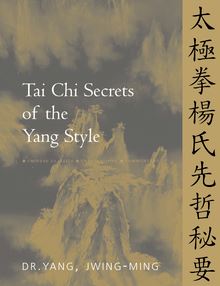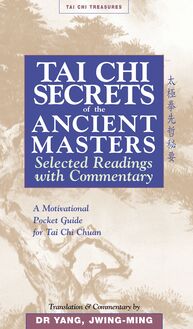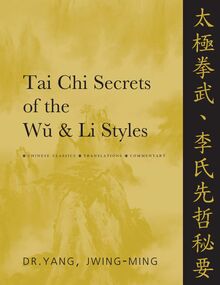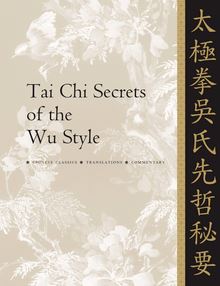-
 Univers
Univers
-
 Ebooks
Ebooks
-
 Livres audio
Livres audio
-
 Presse
Presse
-
 Podcasts
Podcasts
-
 BD
BD
-
 Documents
Documents
-
- Cours
- Révisions
- Ressources pédagogiques
- Sciences de l’éducation
- Manuels scolaires
- Langues
- Travaux de classe
- Annales de BEP
- Etudes supérieures
- Maternelle et primaire
- Fiches de lecture
- Orientation scolaire
- Méthodologie
- Corrigés de devoir
- Annales d’examens et concours
- Annales du bac
- Annales du brevet
- Rapports de stage
La lecture à portée de main
Vous pourrez modifier la taille du texte de cet ouvrage
Découvre YouScribe en t'inscrivant gratuitement
Je m'inscrisDécouvre YouScribe en t'inscrivant gratuitement
Je m'inscrisEn savoir plus
Vous pourrez modifier la taille du texte de cet ouvrage
En savoir plus

Description
Secrets of the Tai Chi Masters Revealed!
Since ancient times Tai Chi Chuan has been practiced as a holistic mind/body fitness system, bringing immense benefits for practitioners in health, longevity, relaxation, and concentration. But it was also practiced as an effective and deadly martial art. Because of this, the masters rarely disclosed their secrets, guarding them as closely as they would military secrets. They preserved their profound insights in obscure songs, poems, and classics, revealing only to those they considered trustworthy and ready. That is, until now. Tai Chi Secrets of the Yang Style contains secrets kept hidden in the Yang family for generations and only revealed to the public in the last two decades.
The majority of the secrets found in this book were written directly by Yang, Ban-Hou, second generation lineage of the Yang family, a master well known for his deep understanding of theory and for the manifestation of martial power (Jin). Now you can reap the benefits of this wisdom and practical experience to deepen and refine your own Tai Chi. Discover ways to reach the essence of your Form and take your Push Hands to higher levels. Dr. Yang, Jwing-Ming has translated these classics from the original Chinese, and has written commentaries to make them more accessible to contemporary minds.
Immerse yourself in the secrets of the Yang Style, the world's most popular style. You'll find Tai Chi Secrets of the Yang Style an invaluable resource for understanding your art.
- Can be used with any style of tai chi chuan.
- Sound, practical advice for any martial art.
- Includes commentaries, translation, and original chinese.
- Key points for incorporating the teachings into your practice.
Sujets
Informations
| Publié par | YMAA Publication Center |
| Date de parution | 16 août 2020 |
| Nombre de lectures | 3 |
| EAN13 | 9781594395000 |
| Langue | English |
| Poids de l'ouvrage | 2 Mo |
Informations légales : prix de location à la page 0,1148€. Cette information est donnée uniquement à titre indicatif conformément à la législation en vigueur.
Extrait
TAI CHI SECRETS OF THE YANG STYLE
Refined work is accomplished through self-disciplinary diligence, ceaseless gongfu is done through constant self-cultivation .
Tai Chi Secrets of the Yang Style
Chinese Classics Translations Commentary
by Dr. Yang, Jwing-Ming
YMAA Publication Center
Wolfeboro, NH USA
YMAA Publication Center
Main Office:
PO Box 480
Wolfeboro, NH 03894
800-569-7988 info@ymaa.com www.ymaa.com
Copyright 2001 by Yang, Jwing-Ming
ISBN: 9781886969094 (print) 9781594395000 (ebook)
Edited by James O Leary
Cover design by Katya Popova
All rights reserved including the right of reproduction in whole or in part in any form.
Publisher s Cataloging in Publication
(Prepared by Quality Books Inc.)
Yang, Jwing-Ming, 1946-
Tai chi secrets of the Yang Style : Chinese classics, translation, commentary / Yang, Jwing-Ming. -- 1st ed.
p. cm.
Includes bibliographical references and index.
ISBN: 1-886969-09-4
1. Tai chi. I. Title.
GV504.Y36 2001 613.7 148
QBI01-201112
Contents
Foreword by Grandmaster Liang, Qiang-Ya
About the Author
Preface
Acknowledgments
Introduction
About the Yang Family
Chapter 1.
The Brief Summary of Taiji, by Yang, Jian-Ho
Chapter 2.
Nine Key Secrets of Taijiquan, by Yang, Yu (Ban-Hou)
2.1 The Secrets of Total Applications
2.2 Thirteen Secret Words of Practicing
2.3 Thirteen Secret Words of Applications
2.4 Eight Secret Words of Techniques
2.5 The Secrets of Insubstantial and Substantial
2.6 The Secrets of Random Ring
2.7 The Secrets of Yin and Yang
2.8 The Secrets of Eighteen Dependencies
2.9 The Secrets of Five Word Classic
Chapter 3.
Forty Taijiquan Treatises, by Yang, Yu (Ban-Hou)
3.1 Eight Doors and Five Steppings
3.2 The Applications of Eight Doors and Five Steppings
3.3 Natural Methods of Discrimination
3.4 Attaching, Adhering, Connecting, and Following
3.5 Butting, Deficiency, Losing Contact, and Resistance
3.6 Matching Without Defaults
3.7 Keeping Central Earth in Matching Practice
3.8 The Body s Shape, Waist, and Crown of the Head
3.9 Taiji Circle
3.10 Taiji s Ceaseless Applications of Advancing and Retreating
3.11 Taiji s Above and Below Discriminated as the Heaven and the Earth
3.12 The Achievements of Eight Words in Taiji s Human61 Circle
3.13 The Interpretation of Taiji s Essence and Applications
3.14 The Interpretation of Taiji s Scholarship and Martial Arts
3.15 The Interpretation of Taiji s Understanding Jin
3.16 The Interpretation of the Eight Doors and Five Gates-Thirteen Postures Long Fist
3.17 The Interpretation of the Reversal of Taiji s Yin and Yang
3.18 The Interpretation of Taiji in the Human Life
3.19 The Interpretation of Taiji Three Achievements of Scholarship and Martial Arts
3.20 The Interpretation of Taiji s Lower Level Martial Aspects
3.21 The Interpretation of Taiji s Orthodox Practice
3.22 The Interpretation of Taiji s Lightness, Heaviness, Floating, and Sinking
3.23 The Interpretation of Taiji s Four Corners
3.24 The Interpretation of Taiji s Balance, Waist, and the Head s Upward Suspension
3.25 The Illustration of Taiji s Four Seasons and Five Qis
3.26 Interpretation of the Foundation in Taiji s Blood and Qi
3.27 The Interpretation of Taiji s Li and Qi
3.28 The Interpretation of Taiji s Meter, Decimeter, Centimeter, and Millimeter
3.29 The Interpretation of Fasciae, Vessels, Tendons, and Cavities
3.30 The Word by Word Interpretation of Taiji
3.31 The Discrimination of Taiji s Controlling, Seizing, Grabbing, and Sealing with Meter, Decimeter, Centimeter, and Millimeter
3.32 The Interpretation of Nourishing and Releasing the Qi and Li in Taiji
3.33 The Interpretation of Emptiness, Congealment, Filing, and Rubbing in Taiji
3.34 The Thesis of Before and After Understanding Jin
3.35 The Thesis of Meter, Decimeter, Centimeter, and Millimeter after Understanding Jin
3.36 The Explanation of Taijiquan s Fingers, Palms, and Pounding Hands
3.37 The Thesis of Oral Transmission of Life and Death in Cavities
3.38 The Legacy of Zhang, San-Feng
3.39 The Oral Transmission of Zhang, San-Feng s Lecture
3.40 The Thesis of Comprehending the Dao from Martial Arts by Zhang, San-Feng
Chapter 4.
Ten Important Keys to Taijiquan, Dictated by Yang, Chen-Fu, Recorded by Chen, Wei-Ming
Chapter 5.
Explanation of Taijiquan s Harmonious Stepping in Four Sides of Pushing Hands, by Yang, Chen-Fu
References
Translation and Glossary of Chinese Terms
Index
Foreword
Liang, Qiang-Ya
Grandmaster Liang, Qiang-Ya
In general, any kind of physical education or training is produced from a defined culture and environment. Consequently, they all have culturally distinctive features. It is the same for Chinese Wushu ( ). The fist techniques (i.e., fighting skills) are standardized and the fist theories (i.e., fighting theories) are expounded, based on Chinese traditional culture. This results in a combined, unified body of scholarship (i.e., internal understanding) and martial arts (i.e., external manifestation). The purpose of searching for the theories of Wushu is to find instructional grounds for Wushu skills and techniques. Wushu s instructional principles and rules, Wushu s training principles and rules, and the specific fist, weapon skills and training methods, all demonstrate the blending of Chinese culture and regular Wushu athletic patterns. For example, in its theory of techniques and skills, Wushu emphasizes the unification of internal and external ( ); Wushu teaching principles stress double cultivation of internal and external ( ) Wushu training guidelines focus on mutual correspondence of internal and external ). In the general standardization of the fist (i.e., barehand) and weapon s movements, it (i.e., Wushu) especially addresses three points corresponding with each other ( ) six harmonizations of internal and external ( ), and five unifications and three urgencies ( ) etc., which therefore demonstrate its external harmonization in the movements, and enrich its internal Yi (i.e., comprehension), the state that possesses both the shape (i.e., external manifestation) and spirit (i.e., internal manifestation). This no doubt is the universal concept of unification of the heaven and the human ( ) which has been emphasized in Chinese traditional culture. Wushu is therefore a practical demonstration of the reality of this internal and external unification. There is not the slightest question that Taijiquan has these same features (i.e., traditional Chinese cultural root).
It seems clear to everyone that Taijiquan is one of the fist styles in traditional Chinese Wushu. As mentioned above, Taijiquan established its theoretical foundation on the illustration of Taiji ( ). I have written a foreword for Dr. Yang, Jwing-Ming s other new book: Tai Chi Secrets of W and Li Styles ( ). In this book, I mentioned that Taijiquan first spread out from Chen s village, Wen county, Henan province, China ( ) at the beginning of Qing dynasty ). From this small territory and clan, it spread across all of China, and now to the whole world. The styles that have developed from Chen style, and which have established their own special stylistic characteristics are: Yang ( ), Sun ( ), W ( ), Wu ( ), and Fu ( )(Zhen-Song) ). These well-known styles have become the most popular fist styles for many practitioners and learners. This is proof that Taijiquan has been advanced and innovated from within continuously. Yang style Taijiquan was the earliest style which was innovated from Chen Taijiquan. It was created by Yang, Fu-Kui ( )(nickname Lu-Chan)( )(1799-1872) who was a disciple of Chen, Chang-Xing ( ) in Chen s village ( ). After Yang finished his learning, he returned to his home village around 1850. Later, he was recommended to Beijing ( ) to be the Wushu teacher in the Beijing Manchurian Loyal military camp ( ). In order to broaden the possibility of learning and also to be adopted more easily by prominent officials and eminent personages (who held the philosophy of jade body does not move (i.e., those who have a precious body do not work) as well as older people, for health maintenance purpose, he revised Chen Style Taijiquan Old Posture and got rid of harder actions such as Jin s emitting (Fa Jin , ) jumping, and the relatively more difficult movements. Thus was created Yang Style Taijiquan. Later it was again revised and edited by his son, Yang, Jian-Hou ( 1839-1917) and his grandson, Yang, Cheng-Fu )(1883-1936), to become today s Yang Style Taijiquan routine.
The postures of Yang Style Taijiquan are comfortable, open, simple, and clear; the movements are loose, soft, slow, and uniform. These special features match the ancient Chinese philosopher Lao Zi s ( ) philosophy of focusing the softness and maintaining the calmness ( ). Yang, Cheng-Fu concluded that there were ten most important keys to practicing Yang Style Taijiquan skills and techniques. They are: insubstantial energy suspends the head upward, draw in the chest and arc the back, loosen the waist, discriminate insubstantial and substantial, sink the shoulders and drop the elbows, use the Yi not the Li, top and bottom are mutually following each other, unification of internal and external, continuous without breaking, and search for calmness within movements. It cannot be denied that all of these new creations were expounded from Chinese traditional cultural philosophy.
Dr. Yang, Jwing-Ming has again collected more secrets of Yang s style and translated them into a book, and again he explains and interprets the related philosophies and theories, from the shallow to the deep. Some of them relate to the practical offensive and defensive applications of postures in Yang Style Taijiquan, and others talk about the philosophy and principles of Taijiquan skills. The purpose of all of this effort is to introduce and spread this gem of the old Chinese traditional culture, Taijiquan, to a greater
-
 Univers
Univers
-
 Ebooks
Ebooks
-
 Livres audio
Livres audio
-
 Presse
Presse
-
 Podcasts
Podcasts
-
 BD
BD
-
 Documents
Documents
-
Jeunesse
-
Littérature
-
Ressources professionnelles
-
Santé et bien-être
-
Savoirs
-
Education
-
Loisirs et hobbies
-
Art, musique et cinéma
-
Actualité et débat de société
-
Jeunesse
-
Littérature
-
Ressources professionnelles
-
Santé et bien-être
-
Savoirs
-
Education
-
Loisirs et hobbies
-
Art, musique et cinéma
-
Actualité et débat de société
-
Actualités
-
Lifestyle
-
Presse jeunesse
-
Presse professionnelle
-
Pratique
-
Presse sportive
-
Presse internationale
-
Culture & Médias
-
Action et Aventures
-
Science-fiction et Fantasy
-
Société
-
Jeunesse
-
Littérature
-
Ressources professionnelles
-
Santé et bien-être
-
Savoirs
-
Education
-
Loisirs et hobbies
-
Art, musique et cinéma
-
Actualité et débat de société
- Cours
- Révisions
- Ressources pédagogiques
- Sciences de l’éducation
- Manuels scolaires
- Langues
- Travaux de classe
- Annales de BEP
- Etudes supérieures
- Maternelle et primaire
- Fiches de lecture
- Orientation scolaire
- Méthodologie
- Corrigés de devoir
- Annales d’examens et concours
- Annales du bac
- Annales du brevet
- Rapports de stage









